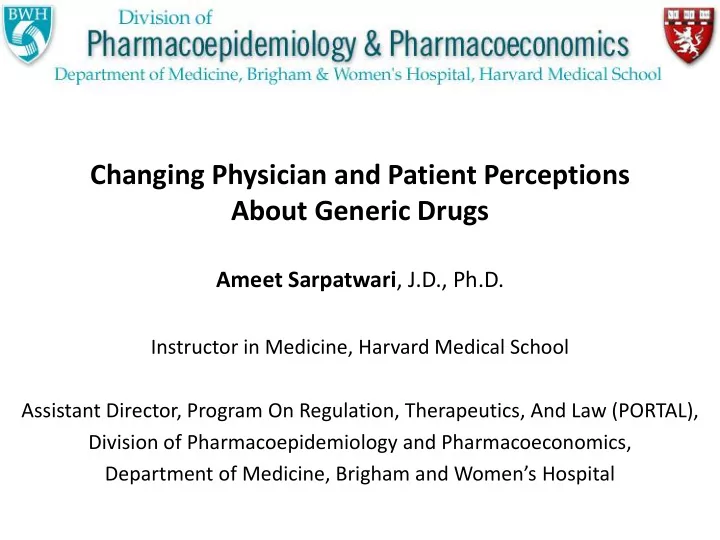

Changing Physician and Patient Perceptions About Generic Drugs Ameet Sarpatwari , J.D., Ph.D. Instructor in Medicine, Harvard Medical School Assistant Director, Program On Regulation, Therapeutics, And Law (PORTAL), Division of Pharmacoepidemiology and Pharmacoeconomics, Department of Medicine, Brigham and Women’s Hospital
Disclosure I have no actual or potential conflicts of interest in relation to this presentation.
The Case for Generic Drugs Savings $1.7 trillion over the past decade 88% of prescription drugs filled, 28% of costs -GPhA & IMS (2015). Clinical interchangeability Substitution with “A - rated” interchangeable generic drugs Bioequivalent: 90% confidence intervals for brand-to-generic ratios of the maximum serum concentration (C max ) and area under the serum concentration curve (AUC) must fall within 0.80 to 1.25 Pharmaceutically equivalent: same dosage strength and form Review of all A-rated generic drugs approved 1996-2007 Average difference: C max =4.4%, AUC=3.6% -Davit et al., Ann Pharmacotherapy (2009). No randomized controlled trials have identified clinically significant variations in outcomes between brand-name and A-rated generic drugs.
Media Spotlighting: Generic Drug Issues Adequacy of approval standards Erroneous understanding “A generic’s maximum concentration of active ingredient in the blood must not fall more than 20% below or 25% above that of a brand name.” -Eban, Fortune (2013). Non-rigorous case reports and observational studies Of particular concern Narrow therapeutic index drugs E.g. , levothyroxine Extended-release products E.g. , extended-release methylphenidate
Objectives To compare pharmacists’ and patients’ perceptions of, preferences for, and responses to changes in pill appearance
Methods: Physicians Target population: actively practicing physicians 300 internists 900 specialists: endocrinology, hematology, and infectious diseases Data source: American Board of Internal Medicine Master File Honorarium: $50 Instrument Questions Demographic information Perceptions of generic drugs Frequency of prescribing generic drugs Mode of administration: email invitation, online completion Date: August 2014-January 2015
Methods: Patients Target population: 1,450 patients Self-reported chronic conditions Filled at least 1 prescription in past 3 months Data source: CVS Advisor Panel Honorarium: CVS Extra Bucks; starting: 2; completing: 15 Instrument Questions Demographic information Perceptions of generic drugs Frequency of requesting generic drugs Mode of administration: email invitation, online completion Date: August 2014
Response Rates and Demographics Physicians Patients N=718 (62% response) N=933 (65% response) Characteristic % (n/N respondents) % (n/N respondents) Age (mean [SD]) 50 (13) 46 (10) Sex -Male 54 (374/687) 41 (306/742) -Female 46 (313/687) 59 (436/742) Race/ethnicity -Caucasian 58 (393/675) 80 (586/733) -Non-Caucasian 42 (282/675) 20 (147/733) Education -US-trained 61 (387/639) N/A -Non-US-trained 39 (252/639) N/A -College graduate N/A 59 (433/733) -Non-college graduate N/A 41 (300/733)
Perceptions Generic Drugs Have The Same [____] As Brand-Name Drugs 100% 95% 91% 89% 88% 90% 87% 84% 85% 80% 80% 73% 75% 70% 65% 60% 55% 50% Effectiveness Safety Active Ingredient Side-Effects Physicians Patients
Evolving Perceptions Generic Drugs Are As Effective as Brand-Name Drugs 100% 95% 89% 90% 87% 85% 80% 77% 75% 70% 70% 65% 60% 55% 50% Physicians-2009 Physicians-2015 Patients-2007 Patients-2014 -Shrank et al., Health Aff (2009). -Shrank et al., Ann Pharmacotherapy (2011).
Physician Preferences Would rather prescribe a generic 70% drug over a brand-name drug Prefer generic drugs when taking 78% medications Recommend generic drugs when 79% advising family members 50% 60% 70% 80% 90% 100%
Patient Preferences 37% 35% 40% 27% 20% 0% Brand-Name Drug No Preference Generic Drug Comfort With Asking to be prescribed a generic drug 94% Taking a prescribed generic drug 97% A pharmacist filling a prescription for a 90% brand-name drug with a generic drug An insurer requiring use of a generic 60% version of a prescribed brand-name… 50% 60% 70% 80% 90% 100%
Physician Actions Sometimes How often do you prescribe a 7% generic drug, if one is Usually 66% available, for a patient who needs a prescription? 27% Always 0% 20% 40% 60% 80% 100% Never When you write a prescription 13% <1% for a brand-name drug for 25% which an FDA-approved 1-5% 27% generic version is available, 16% 6%-20% how often do you specifically 10% request pharmacists not fill it 21%-50% with the generic? 8% >50% 0% 20% 40% 60% 80% 100%
Patient Actions 54% Never How many times have you 15% 1 asked a doctor to prescribe a brand-name drug rather than a 2-3 20% generic in the last year? 4 or More 10% 0% 20% 40% 60% 80% 100%
Predictors of Perceptions and Actions Multivariable logistic regression Adjustments Physicians: demographic and practice variables Patients: household income, education, and age Physicians Learning about generic drug availability from drug representatives Generic skepticism: 35% vs. 30% (p=0.26) Brand-name only prescribing: 47% vs. 30% (p<0.001) Patients Non-Caucasians Generic skepticism: 43% vs. 29% (p<0.01) Requested brand-name drugs: 56% vs. 43%% (p<0.01)
Conclusions Vast majority of physicians and patients have positive views of generics Substantial increase over earlier national surveys Lingering negative perceptions and suboptimal practices exist Generic skepticism: 32% Dispense as written >5% of prescribing: 34% Targeted educational outreach possibly beneficial Minority patients Physicians who frequently interact with brand-name drug companies
Acknowledgements Aaron S. Kesselheim, M.D., J.D., M.P.H Joshua J. Gagne, Pharm.D., Sc.D. Wesley Eddings, Ph.D. Jessica M. Franklin, Ph.D. Kathryn M. Ross, MBE Lisa A. Fulchino Eric G. Campbell, Ph.D. Jerry Avorn, M.D.
Recommend
More recommend